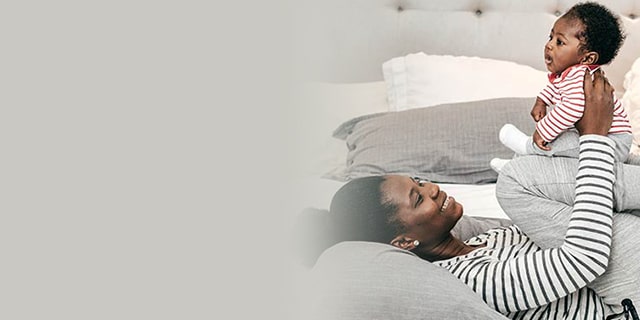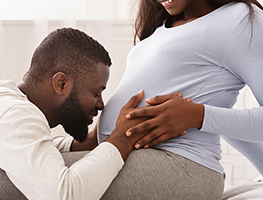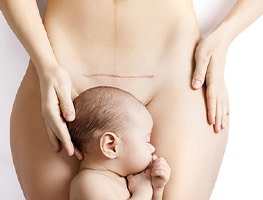The perineum is the area which lies between the vaginal opening and the anus. Most women aren’t really conscious of this region until they become pregnant and start reading about childbirth. Then it can become the topic of much conversation and concern.
During childbirth, as the baby’s head descends further towards the vaginal opening, the perineum starts to stretch and become thinner. In most women this stretching is sufficient to allow their baby’s head to emerge and the body to follow.
The length of the perineum varies between individual women and this can impact on the chances of tearing or needing to have an episiotomy. Perineal stretching exercises, when done during pregnancy, can help to increase the capacity of the perineum to stretch during labour. This reduces the likelihood of perineal tearing or the need to have an episiotomy.
What is an episiotomy?
An episiotomy is a surgical cut made in the perineum by the midwife or obstetrician, to make the vaginal opening larger. When the baby’s head is pressing so firmly against the perineum that there is a risk of it tearing uncontrollably, a cut approximately 2-4 cm long is sometimes made. Local anaesthetic is injected into the perineum before an episiotomy is cut, unless the woman has had an epidural in which case additional numbing of the area may not be necessary.
There is a lot of controversy over how appropriate it is for healthcare professionals to cut an episiotomy. Some view it as a form of abuse and rarely necessary.
Sutures, or stitches, are necessary if an episiotomy has been cut. These help with healing and to bring the skin edges neatly together. Some women experience a tear in their perineum during childbirth, which may also require stitches.
Generally, the criteria for stitching a perineal tear are:
If the tear is jagged and the skin edges do not fit well together
If the muscle layers within the perineum have been involved
If there is a lot of bleeding from the tear – stitches help to stop bleeding and maximise the chances of quick healing
Different categories of perineal tearing
A first degree tear involves injury to the skin
A second degree tear involves the muscles of the perineum
A third degree tear extends along the perineum and into the anus
A fourth degree tear involves the perineum and the anus as well as the bowel tissue
A midwife or obstetrician can suture an episiotomy or perineal tear. Usually local anaesthetic is given which numbs the area. Nitrous oxide gas is another pain relief option, if it is available. Dissolvable suture material is almost always used. This means the stitches do not need to be taken out, and they will start to dissolve from around one week after delivery. Sometimes they can be seen as they come off onto toilet paper, in the shower or onto a sanitary pad. Very occasionally, if they do not dissolve, the sutures need to be removed by a healthcare professional.
It is common to experience a pulling or tight sensation in the area where the stitches have been inserted. This can be worse when there is localised swelling. Within a few days, this sensation should ease but if it doesn’t, it is important to tell your midwife or obstetrician. Occasionally, tight suturing causes the vaginal opening to become too small which then impacts on normal sexual functioning.
Small vaginal or perineal tears are often left to heal themselves. There has been much research looking at the healing time of tears that have been sutured compared with those that have been left alone to heal. Similarly, pain levels have been monitored and compared in postnatal women, within these two groups. It appears that women with sutures experience slightly more pain than those who are left to heal themselves.
Again, individual differences, healing rates, pain thresholds and the type of birth all play a role.
When is an episiotomy done?
Sometimes an episiotomy is done when the baby has become distressed and it is important for them to be born quickly
During a forceps or instrument delivery
When a baby is premature or there is a multiple birth
When a baby is in the breech position
When the baby’s head is very large and there has been no time for the perineum to stretch enough to let it through
After childbirth
Many women experience pain, tenderness and swelling around the perineal area after their baby is born. Ideally, the perineum remains intact during childbirth, stretching as it needs to, allowing the baby’s head and body to be delivered.
What’s normal perineal pain?
It is common to have some swelling and tenderness in the perineal area after birth.
An episiotomy or tear which needed sutures can create a great deal of discomfort, especially within the first few days after birth.
Passing urine can be very painful and cause a stinging sensation.
Perineal pain tends to peak on the second day after birth though it usually improves within a week.
Even if there is no visible sign of trauma to the perineum, small grazes can cause stinging until they have healed.
It can take 4-6 weeks for the perineum to heal completely.
Perineal healing – what helps?
Ice packs applied to the perineum help to reduce swelling. Ideally they are used in the first 24-72 hours, depending on how soothing they feel. A covered ice-brick or the finger of a disposable glove which has been filled with water and then frozen can be very effective. Alternately, crushed ice in small plastic bag, covered with a wet facecloth can be useful.
Hygiene is extremely important and helps to reduce the risk of infection. Showering at least twice each day, washing the perineal area with a mild soap or body wash, patting dry with a clean, soft towel or disposable paper towel will all help with healing.
When having a bowel motion, support your perineum and stitches by holding a sanitary pad over the perineal area.
Some physiotherapists use ultrasound therapy over the perineum which helps to reduce swelling and pain. This is generally done 24-36 hours after the birth.
It is important to wipe yourself properly after emptying your bladder or bowels. Be very careful about wiping from the front towards the back. Showering after a bowel motion is recommended, even if you just wash your lower half.
Don’t economise on cheaper forms of toilet paper. Aim for comfort over cost, even if you need to quarantine your own supply from the rest of the family!
Keep the perineal area as dry and as clean as possible. Avoid using talcum powder or highly perfumed washes or lotions.
Change sanitary pads often and dispose of them properly. Hand washing is important to minimise the risk of infection.
Rest whenever possible. Standing for long periods can lead to swelling and an increase in pain and discomfort. Similarly, sitting in one position can lead to blood congestion in the vulval area. When lying down try lying alternately on each side and resting your upper leg on a pillow.
Avoid becoming constipated. Drink plenty of water each day, at least 8 glasses a day or more if you are breastfeeding; and eat a diet high in fibre and include fruit, vegetables and protein which will all help with tissue healing. Straining to empty your bowels can cause straining of the suture lines and further swelling. Take your time when you go to the toilet and avoid rushing.
Getting out of bed from your side, rather than from a sitting position. This helps to avoid stretching of the perineal area.
Doing pelvic floor exercises as soon as possible after your baby is born. Contact the physiotherapy department of your maternity hospital.
If you are bothered by stinging when passing urine, try standing under a warm shower or pour warm water over your vulval region as you pee. A plastic squirt bottle filled with warm water can be useful.
Avoid resuming sexual intercourse until you feel comfortable and your perineum has healed. Many women find it takes at least 6 weeks for their vaginal and perineal area to stop feeling some degree of tenderness.
You may find you need to take pain relief medication in the first week or so after birth. Speak with your midwife or obstetrician about what’s right for you. Bear in mind that many medications are excreted in breast milk so be careful about the type, dose and frequency of what you are taking.
What doesn’t help the perineum to heal?
Salt baths or long soaking in hot baths
Sitting on a circular air or rubber ring
Resuming sexual intercourse before the perineum has fully had a chance to heal
Heat packs
Antibiotics – unless there is an infection present
Lifting or straining, so avoid picking up heavy loads, toddlers, older children or moving furniture
Vigorous exercise, squatting or any movement in which the legs are straddled and the perineal area needs to stretch before it has healed
Using tampons
Being economical about how many sanitary pads you are using; it is important to try and keep the perineal area clean and dry, so replace pads every 2-3 hours or more regularly if they are soaked
What do I need to be aware of?
Passing large blood clots – after sitting or lying still for a long period of time, it can be normal to pass blood clots, but if you pass a lot of them, they just carry on coming, or you are worried, see your doctor
Pain in the perineal area which does not ease: throbbing, aching, abdominal pain or continual discomfort that is not improving needs to be checked by a healthcare professional
An offensive or smelly vaginal discharge
If you develop on-going pain, stinging or scalding when you pass urine, this can be a sign of a urinary tract infection
A pulling sensation on your perineum, which makes movement and walking difficult
Developing an elevated temperature or feeling as if you have an infection (a normal temperature range is up to 37. 3 °C)
You will need to make an appointment to see your midwife, obstetrician or GP 6 weeks after your baby is born. They will check to see if your perineal area has healed. If, in the meantime you are at all concerned about any aspect of your recovery, do not hesitate to get yourself checked.























